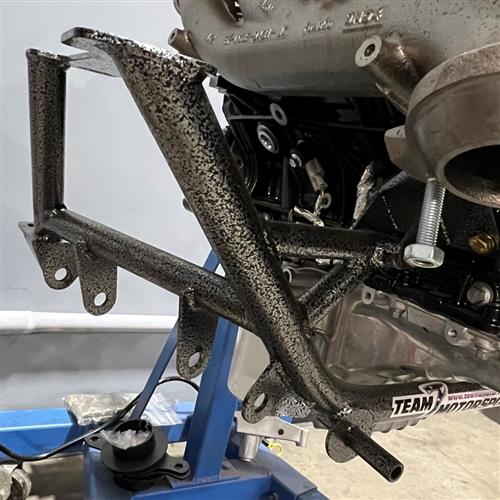

“When all is said and done, we’re going to use the mockup car as a project and make it as light as we can get it, and take a stock engine with better, non-plastic intake, a big turbo, throw boost at it, and see what the engine’s limits are and just how fast we can get it to go,” says Zimmerman.The Fox-Body Ford Mustang is one of the most popular chassis choices in history for drag racing. It is also working with several different exhaust companies to develop headers and is working internally on forward-facing turbo headers for the engine. Since the ability exists to use transmissions like the C4 and Turbo400, Team Z also plans to offer transmission crossmembers for each of those applications combined with the Godzilla engine. “It packages nicely because of the deck height and all that it’s a little bit nicer than a Windsor and fits right in there,” he says. Zimmerman also says you can use factory control arms with modifications, but why would you do such a thing when Team Z’s components exist? It doesn’t alter the wheelbase and can be used with Team Z’s non-adjustable or adjustable control arms. The solid engine mounts are designed for maximum clearance and maximum strength. We got the engine location right we’ve got a crossmember made that will allow you to do that,” says Zimmerman. “Fitting it into a Fox tunnel with a newer transmission - the transmission is huge - was a pain in the butt. The pushrod engine is 4.5-inches narrower than the Coyote, and since we’ve seen plenty of Coyote/Fox marriages, it’s a no-brainer to understand that the Godzilla is ripe and ready for race duty in the Mustang.įitment of the Team Z Motorsports K-member system into the Fox chassis with Godzilla on top was not as difficult as you might expect. What does this mean for an enthusiast who wants simple, big-inch Ford pushrod power? That the Godzilla is, quite simply, an easy swap into a Fox Mustang in terms of fitment and clearance. Cylinder heads with a simple rocker arm arrangement on top like those atop the Godzilla platform are notably less bulky than a dual-overhead-cam arrangement like the Coyote. It is important to note that even though the Godzilla 7.3-liter engine features nearly 50-percent more displacement than Ford’s noted Coyote 5.0-liter engine, it is physically smaller thanks to the pushrod camshaft configuration. Team Z will have transmission crossmembers to fit all popular transmission configurations. A forged steel crankshaft combines with cast pistons to produce 10.5:1 compression as delivered and helps to keep things affordable we expect anyone subjecting this engine to severe abuse will have a quick set of cast ashtrays on the shop bench. The cast-iron block means strength, while the aluminum cylinder heads help keep weight down to a semi-manageable advertised 580 pounds in crate form. In factory configuration, the engine displaces 443 cubic-inches by utilizing 107.2 mm of bore and 101 mm of stroke. In the below video from noted Ford nerd Evan Smith, Wolfe discusses its capabilities and other notable information. With traditional racing components like high-strength forged pistons and connecting rods, along with stiff pushrods and rocker arms, the engine should be quite the performer on the track. It is important to note that Wolfe feels the engine will be extremely durable in race configuration as its development focused on long-term durability in the highly stressed Super Duty truck platform, short race blasts should be no problem for the beefy components used in these engines. So far, he’s cranked out nearly 800 horsepower on the dyno from one of these engines in 12.5:1 compression in a naturally-aspirated configuration, and with plans to put a 3.0-liter Whipple Gen 5 supercharger on top, there’s no doubt he’ll be able to develop the necessary horsepower to be on the pace. It should be a breeze to fit headers in the engine bay, whether long-tubes for NA and supercharged action or forward-facing shorties for turbo engines.Īs such, he has been working on its development with noted engine guru David Visner of Visner Engine Development and other well-heeled engineers to flesh out its capabilities. Despite nearly two liters more displacement than the vaunted Coyote, Godzilla is significantly narrower due to the pushrod engine configuration.


 0 kommentar(er)
0 kommentar(er)
